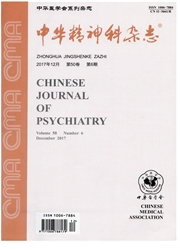

 中文摘要:
中文摘要:
目的 探讨单相和双相抑郁障碍患者以及健康对照者脑白质网络节点全局效率属性值的异同并与临床特征进行相关分析.方法 对24例单相抑郁障碍患者(单相抑郁障碍组)、17例双相抑郁障碍患者(双相抑郁障碍组)以及52名健康对照者(对照组)进行弥散张量成像扫描,并采用17项汉密尔顿抑郁量表(17-Item Hamilton Depression Rating Scale,HAMD17)对患者进行临床评估;利用解剖学自动标记模板将整个大脑划分为90个区域,同时对全脑进行确定性纤维追踪,基于复杂理论方法构建脑白质网络;采用单因素方差分析和双样本t检验方法比较3组脑网络节点全局效率属性值的差异,并对差异脑区的全局效率属性值与临床特征进行Pearson相关分析.结果 (1)3组间全局效率属性值差异有统计学意义的脑区包括左侧扣带回前部(F=10.88,P=0.00)以及右侧内侧额上回(F=14.04,P=0.00)、尾状核(F=9.53,P=0.00)、苍白球(F=12.83,P=0.00).(2)单相抑郁障碍组左侧内侧额上回(0.44±0.03与0.47±0.03,t=-3.73,P=0.02)、丘脑(0.44±0.04与0.47±0.04,t=-3.29,P=0.03)以及右侧内侧额上回(0.40±0.02与0.42±0.03,t=-3.30,P=0.03)、右侧苍白球(0.37±0.01与0.39±0.02,t=-5.07,P=0.00)全局效率属性值较对照组下降.(3)双相抑郁障碍组左侧内侧额上回(0.43±0.03与0.47±0.03,t=-4.81,P=0.00)以及扣带回前部(0.47±0.03与0.51±0.03,t=-4.34,P=0.00)全局效率属性值较对照组下降;而右侧尾状核(0.47±0.03与0.45±0.02,t=3.39,P=0.04)全局效率属性值较对照组升高.(4)双相抑郁障碍组左侧扣带回前部全局效率属性值较单相抑郁障碍组下降(t=-3.85,P=0.02);而右侧尾状核(t=3.91,P=0.03)以及苍白球(t=3.75,P=0.04)全局效率属性值较单相抑郁障碍组升高.(5)单相抑郁障碍组左侧扣带回前部全局效率属性值与焦虑躯体化因子分(r=-0.43,P=0.04)呈负相关;双
 英文摘要:
英文摘要:
Objective To explore the differences of the nodal global efficiency (GE) of brain white matter networks in the unipolar depression (UD) patients,bipolar depression (BD) patients and healthy controls (HC) subjects.Method The diffusion tensor imaging data were obtained from 24 UD patients,17 BD patients and 52 HC subjects.And the 17-Item Hamilton Depression Rating Scale (HAMD17) was used to evaluate the patients' condition.The whole cerebral cortex was divided into 90 regions by the automated anatomical labeling map.Fiber tracking was performed in the whole cerebral cortex of each subject to reconstruct white matter tracts using the fiber assignment by continuous tracking algorithm.And then the brain white matter networks were constructed using the complex network theory.The nodal GE of the brain networks of UD,BD and HC were compared by the one-way ANOVA and two sample t-tests,and then the correlations between the GE of the significant nodes and the clinical features of patients were explored by the Pearson correlation analysis.Result The significant nodes of the GE in there groups included the left anterior cingulate gyri (F=10.88,P=0.00) and right medial superior frontal gyrus (F=14.04,P=0.00),caudate nucleus (F=9.53,P=0.00),pallidum (F=12.83,P=0.00).The GE of UD was descendant significantly in the left medial superior frontal gyrus (0.44±0.03 vs.0.47±0.03,t=-3.73,P=0.02),thalamus (0.44±0.04 vs.0.47± 0.04,t=-3.29,P=0.03) and right medial superior frontal gyrus (0.40±0.02 vs.0.42±0.03,t=-3.30,P=0.03),caudate nucleus (0.37 ±0.01 vs.0.39± 0.02,t=-5.07,P=0.00) when compared with HC.The GE of BD descent significantly in the left medial superior frontal gyrus (0.43±0.03 vs.0.47±0.03,t=-4.81,P=0.00) and anterior cingulate gyri (0.47±0.03 vs.0.51±0.03,t=-4.34,P=0.00),however,increased significantly in the right caudate nucleus (0.47±0.03 vs.0.45±0.02,t=3.39,P=0.04) when compared with HC.The GE of BD was descendant significantly in the le
 同期刊论文项目
同期刊论文项目
 同项目期刊论文
同项目期刊论文
 期刊信息
期刊信息
